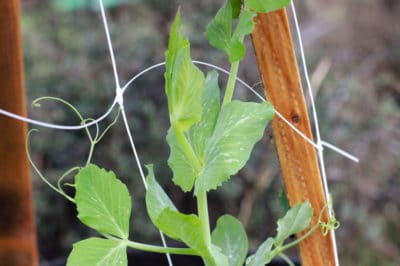Stand Alone Trellises
For individual pea plants or small patches, stand-alone trellises can be constructed out of a large variety of materials. Read the seed packet of your peas to know exactly how tall to build the trellis, some peas grow to 16 inches and other can reach 6 feet. To assemble a stand-alone pea trellis you can use:
- Boards (1×1, 1×2, or smaller)
- Tree limbs and branches
- Bamboo stakes
- Old wire fencing
- Cattle Panels
- PVC
One easy method consists of finding interestingly shaped tree limbs and just shoving the ends into the ground until they are sturdy. You can start with one limb and then add on to it if you have more peas. Otherwise, form a small cage around your pea plants similar to a tomato cage. You may have to help them get started climbing, but if there are adequate things to hold onto the peas will be off and running.
Row Trellises
If your peas are planted in rows, then you’ll need a long row trellis. It should be sturdy and allow easy access for weeding and harvesting. There are two common methods for assembling a row-trellis.
Single-Post Row Trellis
A single-post row trellis has just one post on either end of the row. Dig two post holes for posts. You can also pound in metal T-posts, tree limbs, whatever you’ve got that will hold a bit of tension. One on each end of the planting bed.
Run twine between them pulling it tight, giving the peas something to grab onto. Alternatively, screw on branches between the posts, use small trellis boards, run a section of fencing or chicken wire across. Anything to allow some support.
Double-Post Row Trellis
A double-post row-trellis involves two posts on either end of the row. Typically these are pounded in and made of a material that will bend like fresh cut branches or bamboo. Pound a post at each corner of the bed.
On each end, bend the two posts together so they cross at the top, forming an arch shape, and secure them. Connect the two crossed ends by lying another stick or branch perpendicular on top of them. It should sit comfortably in the nooks above where the posts cross and provide stability.
Again, run twine, wire, branches, fencing, or anything else you have between the posts. With a two post system, you can run twine in two dimensions to create a box of verticle growth space.
